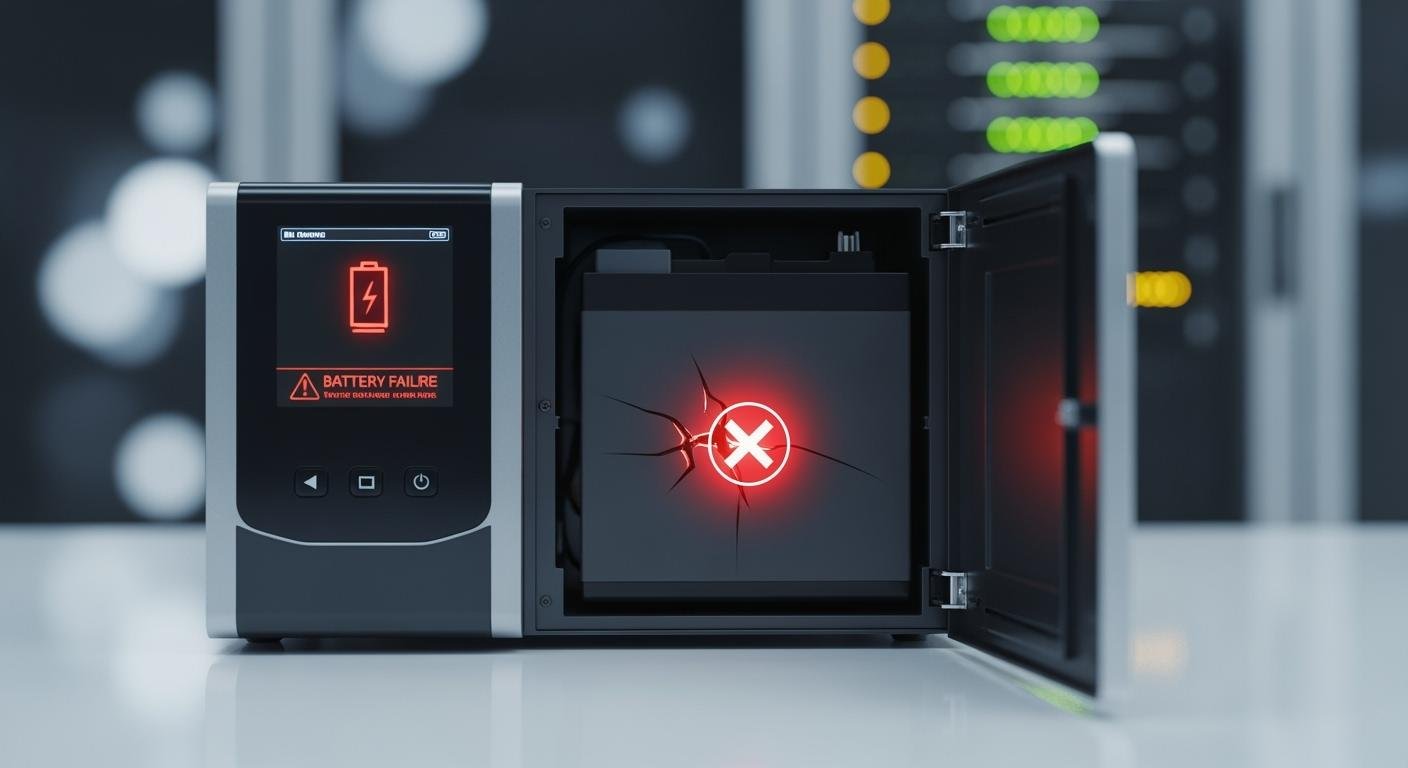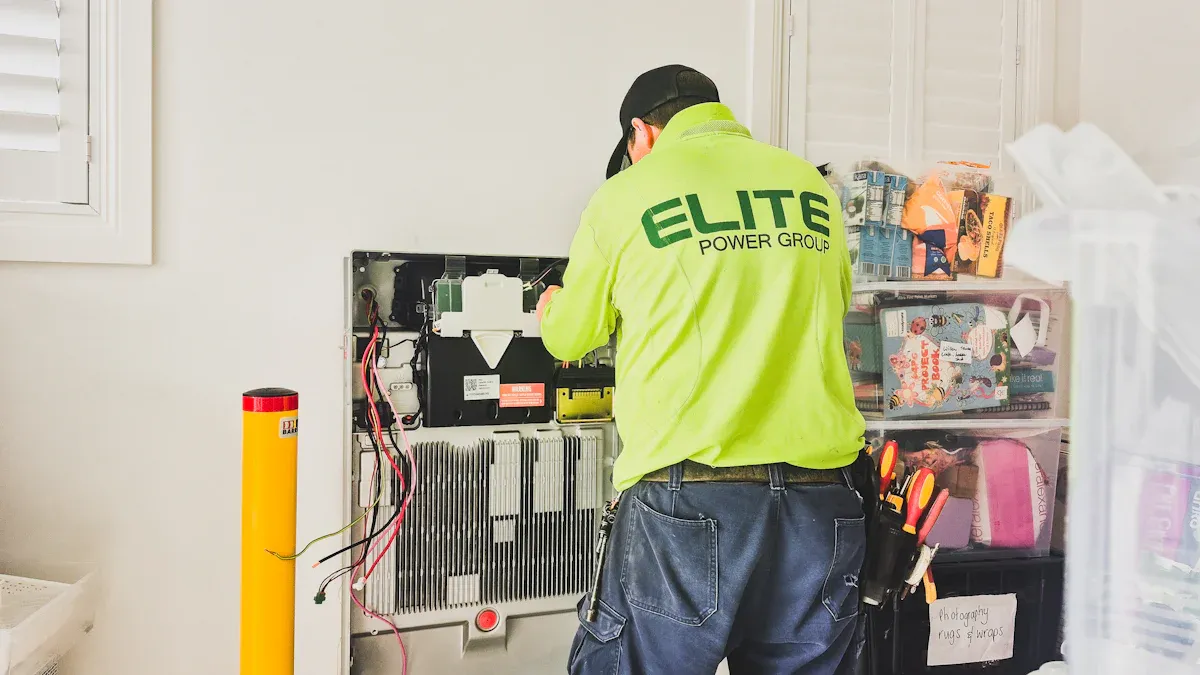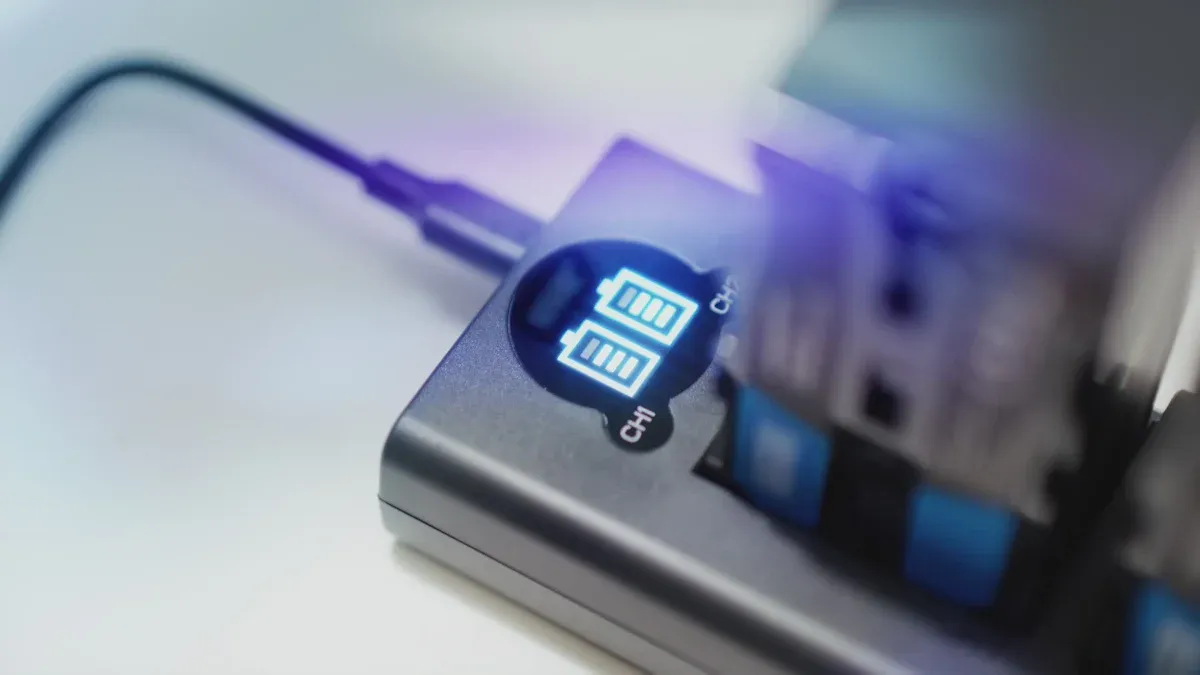
Battery failure causes 65% of all UPS downtime. A single UPS systems battery failure can trigger costly outages and expensive downtime. This failure is a major risk for any business.
Average Cost of Downtime (Per Minute) | Business Size | Cost | |—|—| | Large Enterprise | ~$9,000 | | Small/Mid-Sized | ~$427 |
Most UPS failures are preventable. You can find clear solutions for your uninterruptible power supply. These preventive steps protect your UPS battery. Preventing UPS failures ensures your UPS is always ready. A reliable UPS depends on its battery. Your UPS needs a healthy battery. This keeps your UPS working.
Key Causes of UPS Systems Battery Failure

You must understand the root causes of failure to prevent unexpected downtime. Many common UPS problems start with the battery. Knowing these causes helps you protect your investment and ensure your UPS is ready for an outage. These are the most common reasons for UPS issues.
High Ambient Temperatures
Heat is the number one enemy of your UPS battery. High temperatures accelerate the chemical reactions inside the battery. This process can lead to a dangerous condition called thermal runaway, where the battery generates more heat than it can release. This causes the internal cells to dry out, resulting in a complete failure.
🌡️ Temperature Rule of Thumb For every 8°C (15°F) increase above the ideal temperature, you can expect the battery’s service life to be cut in half.
Your UPS batteries perform best within a specific temperature range.
- The ideal operating temperature is between 20°C to 25°C (68°F to 77°F).
- Manufacturers base the rated capacity и design life of a battery on an ambient temperature of 25°C (77°F).
Keeping your UPS in a cool, well-ventilated area is critical for avoiding premature failure.
Improper Charging & Float Voltage
Your UPS uses a specific charging voltage to keep the battery ready. This is called the float voltage. Setting this voltage incorrectly is one of the most common UPS problems and causes serious damage.
| Charging Issue | Consequence |
|---|---|
| Перезарядка | Excess energy causes gassing, where water inside the battery turns into gas and escapes. This leads to cell dry-out, grid corrosion, and potential thermal runaway. |
| Undercharging | The battery never reaches a full charge. This allows lead sulfate crystals to build up on the battery plates, a process called sulfation. Sulfation reduces capacity and shortens the battery’s life. |
An incorrect float voltage directly contributes to UPS failures. You must ensure your UPS is calibrated correctly to avoid these damaging conditions.
Frequent Over-cycling & Deep Discharges
A UPS battery is designed for a limited number of discharge-recharge cycles. Each time your UPS switches to battery power, it uses one of these cycles. Frequent power outages cause over-cycling, which wears out the battery much faster than intended.
Deep discharges create even bigger issues. When you drain a battery too much, large lead sulfate crystals form on the internal plates. These crystals are difficult to remove during recharging. This process can warp the plates, increase internal resistance, and permanently reduce the battery’s capacity, leading to an early failure. This is a major factor in UPS systems battery failure.
Poor Installation & Connections
A proper installation is your first line of defense against common UPS problems. Simple mistakes during setup can cause significant trouble later. Common installation errors include:
- Placing the UPS in a location with poor ventilation.
- Choosing the wrong type or capacity of batteries for your UPS.
- Failing to tighten all connections properly.
Loose inter-cell connections are especially dangerous. A loose connection creates high resistance. This resistance generates heat at the connection point and can cause uneven charging across the battery string. This is a hidden cause of failure that you can easily avoid with a careful installation. If you need to troubleshoot UPS issues, always check the connections first.
Simple Age & Component Degradation
Even with perfect care, every UPS battery has a limited lifespan. Over time, the internal components simply wear out. Most Valve-Regulated Lead-Acid (VRLA) batteries used in UPS systems have a typical service life of 3 to 5 years under optimal conditions.
As a battery ages, you can look for physical signs of degradation. These signs warn you of a potential UPS systems battery failure.
- Опухоль или выпуклость of the battery case.
- Corrosion or leakage around the terminals.
- Discoloration of the case, often from heat.
- An unusual sulfur or rotten egg smell.
Seeing any of these signs means it is time to replace your battery immediately. Proactive replacement is the only solution for failure due to old age.
Solutions to Resolve UPS Battery Issues

You can prevent most UPS systems battery failure with the right strategies. These solutions help you resolve UPS battery issues before they cause an outage. Protecting your UPS means protecting your business operations. Follow these steps to ensure your power protection is always reliable.
Maintain Optimal Temperature
You must control the temperature around your UPS. Heat is a battery’s worst enemy. A cool environment extends battery life and ensures reliable service.
💡 Cooling Tip Avoid cooling an entire room. This approach wastes energy. Instead, you should focus cooling efforts directly on the equipment. Consistent temperatures prevent moisture and condensation, which can damage your UPS.
Here are some effective cooling strategies:
- Manage Airflow: Arrange your server racks in a hot-aisle/cold-aisle layout. This setup stops hot exhaust air from mixing with cool intake air. You can also use blanking panels to seal unused rack spaces and improve cooling efficiency.
- Use Precision Cooling: Deploy cooling systems that target specific hotspots. These units direct cool air right where your batteries are, preventing them from overheating.
- Monitor Temperatures Continuously: Install remote temperature sensors in your battery enclosures. These devices provide real-time data and send alerts if temperatures exceed safe limits. This automated monitoring reduces human error and helps you act before damage occurs.
Implement a Regular Maintenance Schedule
Regularly scheduled preventive maintenance is the key to a healthy UPS. A consistent maintenance schedule helps you find and fix small problems before they lead to a major failure. You should perform inspections to check for physical wear and test electrical performance. This preventive service saves you from expensive emergency repairs later.
Your quarterly maintenance checklist should include these ups maintenance tips:
- Visual Inspection: Look for physical signs of wear. Check for a bulging or swollen battery case, corrosion on the terminals, or any fluid leaks.
- Voltage Checks: Use a multimeter to measure the voltage of each battery. This helps you identify weak cells before they cause a failure.
- Connection Integrity: Inspect all wiring and connections. Use a thermal-scanning tool to find loose connections that generate excess heat. Tighten them to the manufacturer’s specifications.
- Environment Check: Measure the room temperature and humidity. Ensure cooling fans are working correctly and without unusual noises.
- Cleanliness: Keep the UPS unit and its dust filters clean. Dust buildup can block airflow and cause overheating.
This timely maintenance routine is a core part of any good ups maintenance plan. Consider scheduling preventive maintenance with a professional for a thorough service.
Ensure Proper UPS Load Management
You must manage the electrical load on your UPS. Overloading the system puts extreme strain on the battery. This strain causes the battery to overheat and fail much faster. Connecting too many devices reduces your runtime и shortens the battery’s lifespan. This is a common cause of overloading and capacity issues.
⚠️ Load Capacity Rule Never run your UPS at 100% capacity. For optimal performance and longevity, you should operate your UPS at around 50% of its maximum load. Always leave at least a 20% buffer, meaning you should not exceed 80% capacity.
For example, if your equipment requires 900 watts, a 1 kVA UPS (which often supports around 900 watts) is a poor choice. It would run at full capacity, leading to stress and early failure. A better solution is a 2 kVA UPS. This would run the 900-watt load at about 50% capacity, ensuring reliability and a longer service life. Proper load testing and capacity verification is a critical part of UPS maintenance.
Correct Calibration and Storage
Your UPS needs correct calibration to report its runtime accurately. An uncalibrated UPS might show you have 30 minutes of battery power when you only have 10. This mistake can lead to a sudden shutdown during an outage. You should calibrate your UPS once or twice a year, or after installing a new battery.
Follow these steps for a manual calibration:
- Charge the UPS: Make sure the UPS has been charging for at least 24-48 hours.
- Apply a Load: Connect a non-critical load that is at least 30% of the UPS capacity.
- Run on Battery: Disconnect the UPS from wall power and let it run until the battery is completely drained and the unit shuts off.
- Recharge Fully: Plug the UPS back in and allow it to recharge completely without any load attached.
Proper storage is also vital for new batteries. If you are not installing a new battery immediately, store it correctly to preserve its capacity.
- Store batteries in a cool, dry place between +5°F and +86°F.
- Recharge the battery at least every six months.
- If storing in a warmer environment (up to +113°F), recharge it every three months.
Proactive Battery Replacement
Every battery has a finite lifespan. Most UPS batteries last 3 to 5 years under ideal conditions. Waiting for a battery to fail is a risky strategy. A run-to-failure approach seems cheap but leads to unplanned downtime, data loss, and expensive emergency repairs. Proactive replacement is a smarter, safer, and more cost-effective service.
Proactive maintenance ensures uninterrupted operation. It lowers unplanned downtime, reduces safety risks, and extends the life of your equipment.
Modern battery monitoring systems use predictive analytics to help you decide when to replace your batteries. These systems analyze real-time data on voltage, temperature, and usage patterns.
- They estimate the Remaining Useful Life (RUL) вашей батареи.
- They detect early signs of trouble, like cell imbalances or rising internal resistance.
- They help you schedule replacements at the perfect time, preventing ups failures while maximizing the battery’s service life.
Don’t wait for an outage to discover a dead battery. This preventive approach is the best way to guarantee your UPS is ready when you need it most. This is the best of all solutions for preventing ups failures.
You can prevent most ups systems battery failure. Your UPS needs these key solutions to avoid unexpected downtime.
- Control Heat: Keep the environment cool.
- Test Regularly: Perform preventive checks.
- Manage Load: Do not overload your UPS.
- Replace Proactively: Change the battery before it fails.
The battery is the weakest link in your uninterruptible power system. A healthy battery keeps your UPS working. These simple checks reduce the chance of failure, ensuring your UPS runs longer. You can avoid most ups failures with a good battery. Your UPS will be ready. A reliable UPS is a protected UPS.
Don’t wait for outages to discover a dead battery. Implement these steps today to ensure your UPS is ready when you need it most.
ЧАСТО ЗАДАВАЕМЫЕ ВОПРОСЫ
How often should I replace my UPS battery?
You should replace your UPS battery every 3 to 5 years. This proactive step prevents unexpected failures. A new battery ensures your UPS is ready for a power outage. Regular replacement keeps your UPS reliable.
What does a constant beeping from my UPS mean?
A constant beep often signals a problem. Your UPS may have a low battery or an internal fault. You should check the user manual for your specific UPS model. This sound tells you the UPS needs attention.
Can I use a car battery in my UPS?
No, you should not use a car battery in a UPS. Car batteries are not designed for the charging cycles of a UPS. Using the wrong type of batteries can damage your UPS and create a safety hazard.
Why is my new UPS battery not holding a charge?
Your new UPS battery might need calibration. A new battery also needs time to charge fully. You should allow the UPS to charge for at least 24 hours. If the problem continues, the battery could be faulty.

